A hail cannon is not a weapon that shoots small balls of ice at the enemy. A hail cannon is intended to prevent hail by disrupting its formation in the atmosphere with acoustic shock waves. If you live in a country like Britain, where hail is relatively rare, and hardly ever bigger than peas, you may be wondering why anyone would bother. But... in other countries hailstones can be much larger and very destructive of crops. I sheltered from a hailstorm (combined with torrential rain) in Florence in 2019, and the hailstones were about 2 cm across. There was no obvious damage to cars but it certainly wasn't something you'd want to be caught out in. Hailstones can be as large as 6 inches across; at even half that size they can cause fatal injuries.
I will say at once that there is no evidence that hail cannon have any effect at all. Thunder creates much stronger acoustic shock waves than any earth-based cannon could, but thunderstorms with hail are not at all uncommon. Historically, attempts to acoustically suppress hail began with the ringing of church bells, (in France) and moved on to rockets and cannon fired with gunpowder.
Modern developments began in 1895 when Albert Stiger, wine-grower and the mayor of Windisch-Feistritz in Styria, Austria, made experiments with conical cannon firing vertically upwards. He settled on a design that produced a circle of smoke that rose up to a height of 300 metres. The cannon was a conical tube, 69 cm in diameter at the top and 20 cm at the base, made of 2 mm thick sheet metal, and mounted on a wooden pedestal.
There is a Wikipedia page for hail cannon.

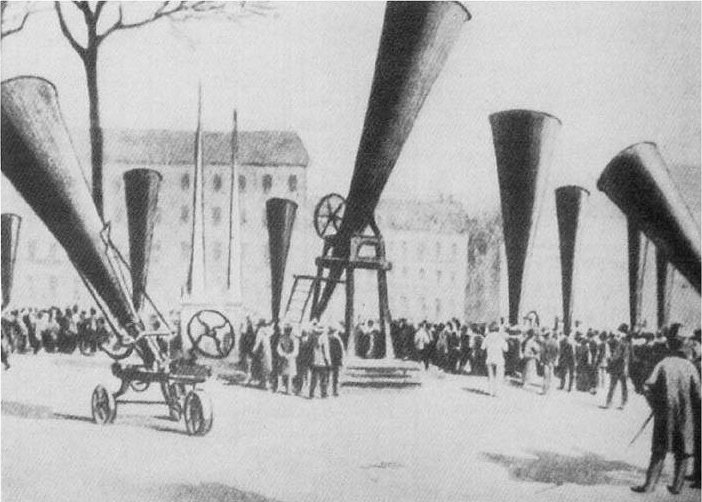 |
| Left: The 3rd International Congress on Hail Shooting at Lyons: 15-17 November 1901
This image commonly appears when you search "hail cannon", and at first I thought it an improbably crowded scene; however there are good records of this conference and many cannon designs were exhibited. The largest on the market, first shown at Padua, weighed 9 tons and was 9 metres high; it could point in any direction. That is very probably the one in the centre of this picture.
You can read the records in The Monthly Weather Review for Jan 1902, pp33-38. There is another account (in French) here.
Twenty-five delegates gave presentations on various aspects of the subject. Interestingly one was called Marconi, representing the Veneto region, but this was Professor M Marconi, Professor of Agriculture at Venice, not the radio pioneer. There was much discussion about the need to demonstrate that hail cannon did (or did not) work. |
Here is an excerpt from The Monthly Weather Review on the Third conference:
"Reports were received from the following persons:
1) Professor Battanchon on the general history of the subject of weather shooting.
2) Guinand, on the results in France during 1901, where 39 operators with 834 cannon protected 22,900 hectares. He reported perfect success in every case; on this Suschnig remarks that he is altogether too optimistic, and that his enthusiasm needs to be modified by a careful discussion of the French data such as has already been done for Austria.
3) Suschnig, a general report for Austria... In general everyone is thoroughly satisfied with the results and no-one doubts that systematic shooting has accomplished good results."
4) Konkoly, for Hungary. The experience of the year has shown that the practical service leaves much to be desired.
5) Ottavi, for Piedmont, Italy. Although there were many hailstorms yet the stations were generally protected, but there were three cases of severe extensive damage to the protected as well as the unprotected, namely on May 17, June 12, and July 22. In many cases the shooting seems to be effective against hail, but in many others not so.
6) Alpe for Lombardy. The shooting stations generally report good results, but cases of failure are believed to be the consequence of poor organisation, feeble cannon or delay in shooting; nevertheless the severe misfortune at Mantua occurred in spite of perfect shooting and cannot be excused.
|
That is interesting, as at shows that (1) hail cannon were big business in France, if nearly a thousand could be deployed. Even more interestingly, Suschnig (3) gets about as close as you can in a publication to calling Guinand a damned liar.
At (6) "The severe misfortune at Mantua" sounds intriguing; presumably it was an exceptionally destructive hailstorm. Regrettably Googling "severe misfortune at Mantua" does not bring up anything relevant. On Googling 'hail Mantua' all we learn is that there is a Mantua, Ohio, in the USA.
The first International Congress on Hail Shooting was held in Casale Monferrato, Piedmont, in 1899, and the second in Padua in 1900. (both are in Italy) By 1900 there were at least 60 different models of hail cannon on the market. For the three days of each congress, the parks and plazas of the cities were thronged with hail cannon.
A Fourth Congress was held in Graz, Austria, in 1902 under the auspices of the Austro-Hungarian Ministry of Agriculture. This congress was attended only by government representatives and scientists, and not the promoters of the various designss. The Congress concluded that the effectiveness of anti-hail guns could neither be confirmed nor denied and recommended further experiments in order to reach a firm conclusion.
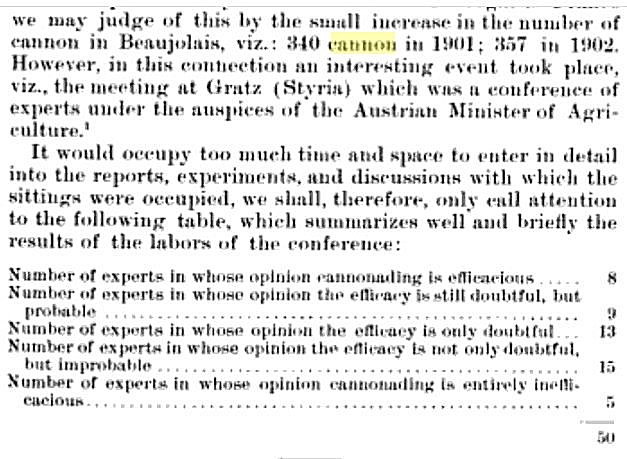 |
| Left: Conclusions from the 4th hail cannon conference: 1902
Looks like 17 in favour and 33 against.
Experments were carried out in 1903 and 1904 in Windisch-Feistritz, Austria (where Albert Stigerwas mayor; today it is called Slovenska Bistrica, Slovenia ) and Castelfranco, Veneto, Italy. The last used a total of 222 cannons, and showed that they could not stop hailstorms. Austria decided to stop the tests at the end of 1906, but after 1905 the use of anti-hail cannons had largely ceased anyway.
Source: The Monthly Weather Review Summary 1902, pp604-607
|
 |
| Left: Conclusions from the 4th hail cannon conference: 1902
|

HAIL CANNON IN AUSTRALIA
 |
| Left: Six hail cannon in Charleville, Australia: 1902
One of the best-known attempts to use hail cannon happened in 1901 in western Queensland, which was in the grip of a severe drought. The idea was to make it rain rather than stop it hailing. Clement Lindley Wragge was official Queensland's meteorological observer, and arranged for six guns to be built by Harvey & Son at Globe Ironworks in Brisbane, and taken to Charleville in an attempt not to stop hail, but to break the drought.
The six hail cannon appear to have been given names; they are labelled Leahy, Suschnig, (The Austrian expert; see above) Harvey, Philip, Stiger, and Wragge. Stiger refers to the inventor Albert Stiger, while Wragge was the meteorologist who organised the attempt. The six items in the foreground are persumably the breech assemblies.
On 26 September 1902, the breech of each was loaded with gunpowder which was detonated. No significant rain fell and the experiment was considered a failure, not least because two of the six guns reportedly exploded. (presumably this means the breech assembly failed) Blame for the failure was directed at the Charleville townsfolk, since Wragge was not on hand to oversee the experiment.
|
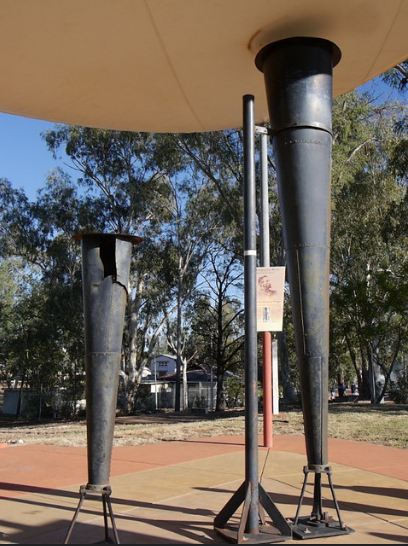 |
| Left: Hail cannon on display in Charleville, Australia: 1902
These are two of the original Charleville hail cannon. They are on display in a Charleville park, and a third exists at Historic House, Charleville. The rest are believed to have been scrapped.
The cannon were made of sheet steel sections riveted together. The base of the cone was fixed to a triangular plate, and three long bolts were used as spacers between the upper triangular plate and a lower rectangular steel plate. The rectangular plate supported a cylinder carrying the gunpowder charge. Three steel tubes were fitted to the underside of the rectangular plate. Two brackets for wall mounting were fitted to the cone.
|
 |
| Left: Stiger hail cannon on display in Charleville, Australia: 1902
This is the hail cannon named after inventor Albert Stiger. The name of Clement Lindley Wragge (the meteorologist) has been written lower down. It says 'The Rain-Maker' at the top. Not true.
Date unknown, but looking at the car in the background at right it was probably in the 1950's.
|

MODERN HAIL CANNON
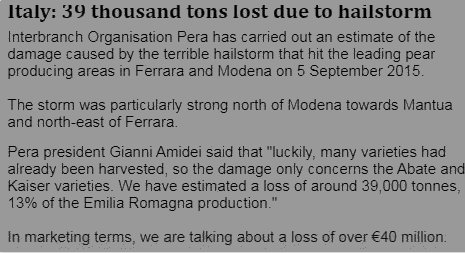 |
| Left: A modern hail disaster: 2015
This recent news item shows that the threat of hail in Italy is still very real, especially at Mantua.
Another case of "severe misfortune at Mantua".
|
 |
| Left: A modern hail disaster: 2021
Severe hail is rare in Britain, but does happen.
A golfball-type hail storm hit Leicestershire at about 18:15 BST on Tuesday 20th July 2021, with car windows obliterated. This used to be a windscreen.
See more on the BBC news.
|
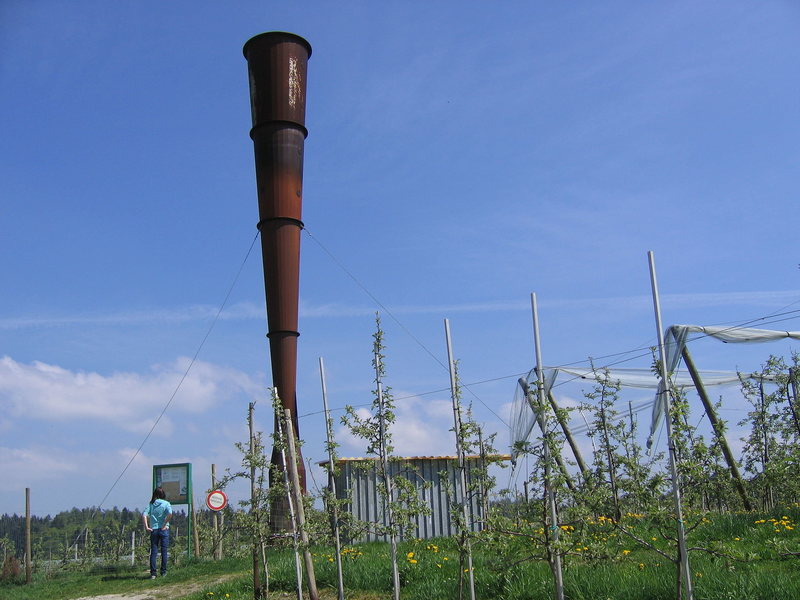 |
| Left: A modern hail cannon in Germany
Modern hail cannon create shock waves by exploding a mixture of acetylene and air at the apex of the horn. This one in Germany appears to be intended to protect apple or pear trees.
Despite the lack of any kind of scientific proof that they work, hail cannon are manufactured today, for example by Eggers.
|
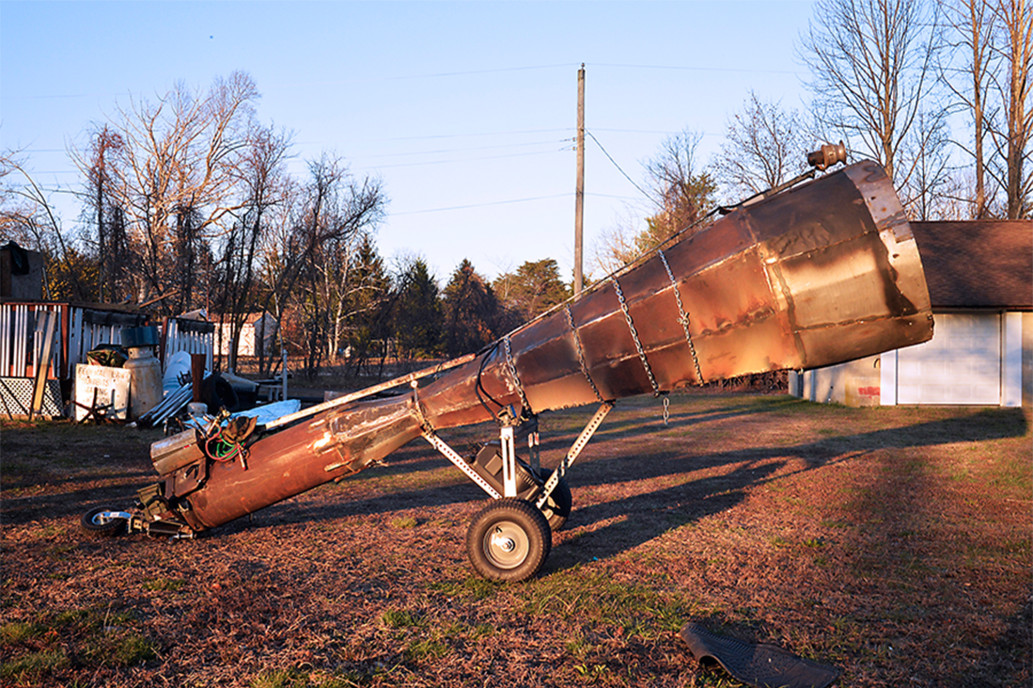 |
| Left: A modern hail cannon in New Jersey
Recently a home-made hail cannon in Hammonton, New Jersey has been causing trouble. Its constructor and proprietor is Rob Butkowski. He claims to be protecting his five-acre vineyard from 'bad weather' and says “You can see the clouds split apart”; I don't believe it. The neighbours are not happy about the noise.
The cannon is 16 feet long and is fuelled with acetylene and oxygen. It was fabricated from scrap metal. Note the reinforcing chains around the main cone at centre-right.
A possible design error is that the cannon does not seem to be able to point upwards, which most hail cannon exponents appear to have thought essential.
Get the full (-ish) story here.
|

THE PARAGRELE
Here is another fallacious method for preventing hail.
 |
| Left: Article on the paragrele concept: 1912
In France some scientists appear to have convinced themselves that hail was caused by static electricity, and here is a plan to prevent hail by installing what were essentially lightning conductors near orchards.
Source Popular Electricity magazine 1912, p758.
|





















